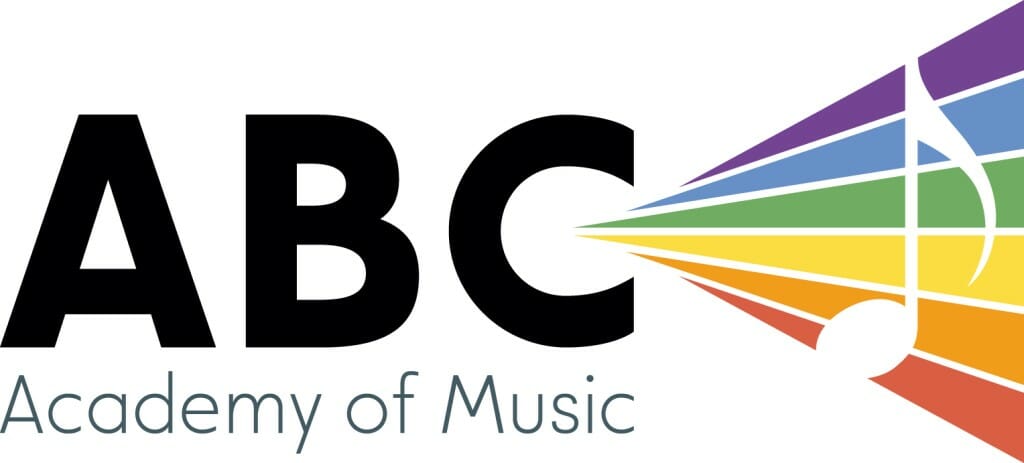A.Dip. (Glenn Gould School)
B.Mus (U of T)
Ariana is a horn player and teacher from Mississauga, Ontario. She has performed is an active soloist, chamber musician, and orchestral player and has performed with groups such as the Etobicoke Philharmonic Orchestra and in festivals such as the Busan Maru International Music Festival in South Korea.
When she isn’t listening to music, in rehearsal or practicing she is probably cooking or wandering her neighbourhood for cats to befriend.
Get to know Ariana…Beyond the Bio!
Hobbies: Film, Politics, Philosophy, RuPauls Drag Race, Crossword Puzzles, trying to learn academic theory by watching youtube videos
Musical Influences: Hermann Baumann, Beethoven, Shostakovich, Lady GaGa, Brahms, Stravinsky, Mozart, Mahler, Kathleen Battle
Favourite food: free food
Least Favourite food: pickled herring
Favourite music: Western Classical, especially feature length symphonic works from the mid 19th century to present
Favourite song: Bad Romance by Lady GaGa
Favourite movie: Fantasia and Fantasia 2000
Favourite movie music: Lord of the Rings
Favourite musical theatre/opera: Fiddler on the Roof
Best quote from your teacher: “Make choices that reflect the person you want to be” – Gabriel Radford
Favourite quote: “I can’t believe I ate the whole thing” – Homer Simpson’s yearbook quote
Favourite book: The Iron Heel by Jack London
Best Thing about teaching at ABC: Giving students tools they can use to nurture their voice as musicians and help them hone skills used in musical study that will be beneficial to them no matter where their musical journey takes them.
Latest Homework from Ariana
Is Ariana Your Teacher?
Sign up now to get your weekly assignments delivered, and never lose your homework sheet again!
Weekly Homework Post
Eliza:
Remember to keep good posture! Sit at the edge of your chair with your feet flat on the ground. keep your head balanced.
Start doing a bit of freebuzzing (buzzing without the horn or mouthpiece) as part of your warmup every day
Continue work on slurring through middle and third space C’s. remember, in order to make the C more accessible, aim beyond it.
Make sure to maintain contact between the bottom lip/teeth and the mouthpiece.
Think of breathing and then playing as one large gesture.
Keep up the good work of moving through your range and using focused air.
Be sure to find your band music this week!
Happy Practicing!

Weekly Homework Post
Eliza:
Try to play every day, even for just a few minutes.
Do buzzing exercises as a part of your warmup, make sure to hold the mouthpiece by the end and to focus on your air and the strength of the buzz, not on making big changes in your embouchure.
Start thinking more about your breathing. Take the air in low, over a couple of seconds.
Continue work on the C major triad, C E G C.
Work on moving between A (the fingering is 1 and 2) and C.
Keep doing work on just moving through your range and feeling where all the notes fit in (if that makes sense, my vague instructions may not be as clear in writing )
Be aware of your posture; sit as if there is a string holding your head up to a neutral position (like a marionette). Keep your feet flat on the floor, and sit at the edge of your chair.
Try to find your band music!
Happy Practicing!
Weekly Homework Post
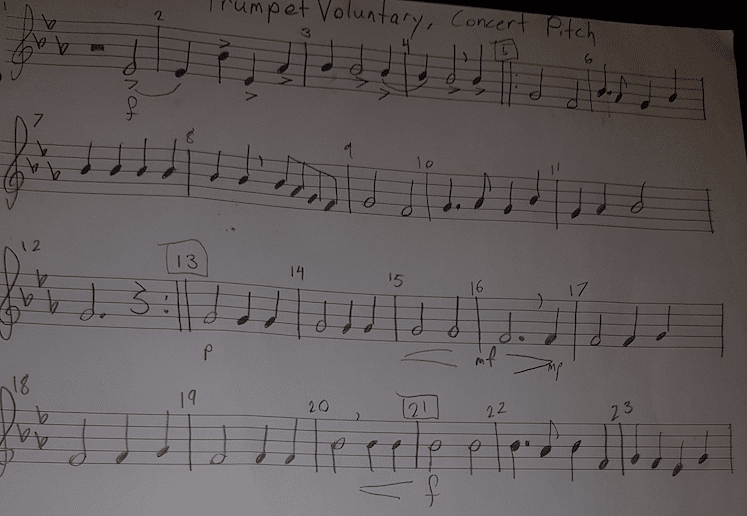
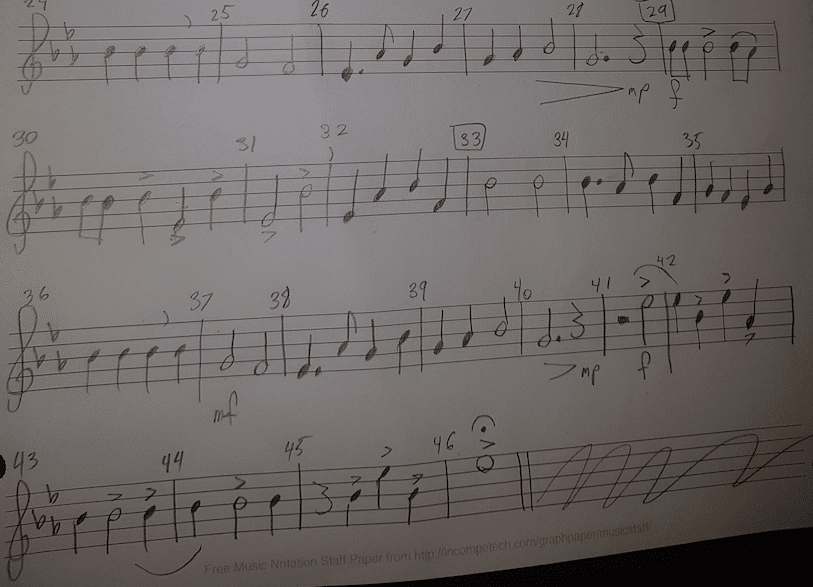
Emma:
Above is trumpet voluntary written in concert pitch so you can use the piano to check pitches while practicing the horn version.
General Reminders:
Sit on the edge of your chair with your feet flat on the ground. Keep your mouthpiece anchored to your bottom lip. Make sure you don’t let the angle of the horn sink down too much, though if your arms are hurting from holding the horn up properly take a short break. Remember to breathe in through your mouth deliberately and with focus
Trumpet Voluntary:
- try to make the switch to primarily B flat side (thumb key) fingerings for this piece specifically. Write them in.
- play along with an E flat concert drone track (like this https://www.youtube.com/watch?v=jgFNsz_9w4A ) to have a reference point for pitch.
- use a metrenome/ tap your feet in rhythm. Being rhythmically aware and precise is important
- practice in small units. don’t just play through the whole thing and hope you make it to the end. the piece will get much easier much faster if you break it into smaller chunk. Isolate specific bars, phrases, intervals, even just specific notes.
Happy Practicing!
Weekly Homework Post
Emma:
- Sit at the edge of your chair with your feet flat on the ground
- Breath in through your mouth, keeping contact between the mouthpiece and the bottom lip. when starting a piece/exercise count in a full bar and breath for two beats
Band Class Skills Test:
- To make sure you have the piece in your ear, play the piece (or just the bar or phrase you intend to work on) on the piano first. Use the band page as the piano part.
- Don’t just power through the whole piece; practice smaller pieces. for example, you can play the first two bars 3 times with a bar of rest between each repetition
- think in subdivisions of eighth notes (1 + 2+ 3+ etc), and write them into your part in places where you could use the reminder
Recital Preparation:

We are going to start working on Russian Hymn, a duet from the Arban’s Cornet Method. Look at it when you can, make note of the accidentals and other instructions provided by the ink. Try both parts if you can to see which one you would like to play.
Happy Practicing!
Preferred Books for Ariana’s Students
Click to buy them here, and they’ll come right to your house! What could be easier?
Solos for the French Horn Player
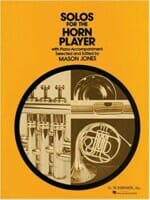
Sixty Selected Studies

Georg Kopprasch was born sometime before 1800, pursued a career as a horn player at least until 1832, and composed two sets of horn etudes which includes this set of 60 etudes, Op. 6. Most of the etudes focus on technical problems relating to the high range of the Horn. 46 pages.
200 New Melodic and Gradual Etudes
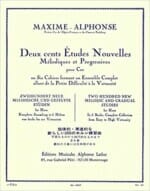
The Art of French Horn Playing
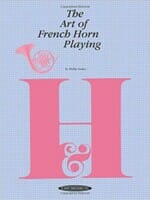 First to be published in the series was The Art of French Horn Playing by Philip Farkas, now Distinguished Professor Emeritus of Music at Indiana University. In 1956, when Summy-Birchard published Farkas’s book, he was a solo horn player for the Chicago Symphony and had held similar positions with other orchestras, including the Boston Symphony, Cleveland Orchestra, and Kansas City Conservatory, DePaul University, Northwestern University, and Roosevelt University in Chicago. The Art of French Horn Playing set the pattern, and other books in the series soon followed, offering help to students in learning to master their instruments and achieve their goals.
First to be published in the series was The Art of French Horn Playing by Philip Farkas, now Distinguished Professor Emeritus of Music at Indiana University. In 1956, when Summy-Birchard published Farkas’s book, he was a solo horn player for the Chicago Symphony and had held similar positions with other orchestras, including the Boston Symphony, Cleveland Orchestra, and Kansas City Conservatory, DePaul University, Northwestern University, and Roosevelt University in Chicago. The Art of French Horn Playing set the pattern, and other books in the series soon followed, offering help to students in learning to master their instruments and achieve their goals.
